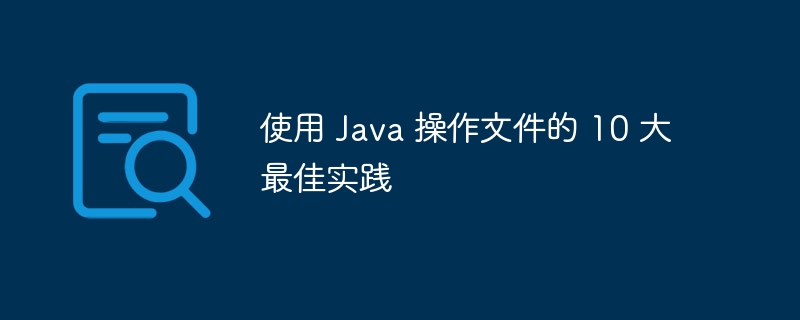Heim >Java >javaLernprogramm >10 Best Practices zum Bearbeiten von Dateien in Java
10 Best Practices zum Bearbeiten von Dateien in Java
- WBOYWBOYWBOYWBOYWBOYWBOYWBOYWBOYWBOYWBOYWBOYWBOYWBnach vorne
- 2024-02-27 19:07:051337Durchsuche

Im Softwareentwicklungsprozess sind Dateioperationen eine häufige Anforderung. Als beliebte Programmiersprache verfügt Java über leistungsstarke Dateioperationsfunktionen. In diesem Artikel werden Ihnen die „Top 10 Best Practices für die Verwendung von Java zum Betreiben von Dateien“ vorgestellt, damit Sie Dateien effizienter und sicherer betreiben können. Ganz gleich, ob Sie ein Java-Anfänger oder ein erfahrener Entwickler sind, Sie werden von diesen Vorgehensweisen profitieren. Dieser Artikel wurde vom PHP-Editor Zimo sorgfältig zusammengestellt, in der Hoffnung, Ihnen bei Ihrer Entwicklungsarbeit zu helfen.
- Verwenden Sie Path und NIO.Path anstelle von File.
// 使用 Path 类操作文件
Path path = Paths.get("my-file.txt");
Files.readAllBytes(path);
// 使用 nio.Path 类操作文件
java.nio.file.Path path = java.nio.file.Paths.get("my-file.txt");
java.nio.file.Files.readAllBytes(path);
- Verwenden Sie Try-with-Resources, um Ressourcen automatisch zu schließen.
try (BufferedReader reader = new BufferedReader(new FileReader("my-file.txt"))) {
String line;
while ((line = reader.readLine()) != null) {
// Process the line
}
} catch (IOException e) {
// Handle the exception
}
- Verwenden Sie die Files-Klasse, um Dateien zu bearbeiten.
// 创建一个新文件
Files.createFile(Paths.get("my-file.txt"));
// 写入文件
Files.write(Paths.get("my-file.txt"), "Hello world!".getBytes());
// 读取文件
byte[] bytes = Files.readAllBytes(Paths.get("my-file.txt"));
String content = new String(bytes);
// 删除文件
Files.delete(Paths.get("my-file.txt"));
- Verwenden Sie BufferedWriter und BufferedReader, um Dateien effizient zu lesen und zu schreiben.
// 写入文件
try (BufferedWriter writer = new BufferedWriter(new FileWriter("my-file.txt"))) {
writer.write("Hello world!");
} catch (IOException e) {
// Handle the exception
}
// 读取文件
try (BufferedReader reader = new BufferedReader(new FileReader("my-file.txt"))) {
String line;
while ((line = reader.readLine()) != null) {
// Process the line
}
} catch (IOException e) {
// Handle the exception
}
- Verwenden Sie FileChannel und MappedByteBuffer, um große Dateien effizient zu lesen und zu schreiben.
// 写入文件
try (FileChannel channel = FileChannel.open(Paths.get("my-file.txt"), StandardOpenOption.WRITE)) {
MappedByteBuffer buffer = channel.map(FileChannel.MapMode.READ_WRITE, 0, 1024);
buffer.put("Hello world!".getBytes());
} catch (IOException e) {
// Handle the exception
}
// 读取文件
try (FileChannel channel = FileChannel.open(Paths.get("my-file.txt"), StandardOpenOption.READ)) {
MappedByteBuffer buffer = channel.map(FileChannel.MapMode.READ_ONLY, 0, 1024);
String content = new String(buffer);
} catch (IOException e) {
// Handle the exception
}
- Verwenden Sie FileVisitor, um Dateien und Verzeichnisse zu durchsuchen.
// 遍历文件和目录
Files.walk(Paths.get("/home/user"), new SimpleFileVisitor<Path>() {
@Override
public FileVisitResult visitFile(Path file, BasicFileAttributes attrs) throws IOException {
// Process the file
return FileVisitResult.CONTINUE;
}
});
- Verwenden Sie die Klasse „Dateien“, um Dateien zu kopieren, zu verschieben und zu löschen.
// 复制文件
Files.copy(Paths.get("src.txt"), Paths.get("dest.txt"));
// 移动文件
Files.move(Paths.get("src.txt"), Paths.get("dest.txt"));
// 删除文件
Files.delete(Paths.get("my-file.txt"));
- Verwenden Sie die Dateiklasse, um Dateiinformationen abzurufen.
// 获取文件信息
File file = new File("my-file.txt");
System.out.println(file.getName());
System.out.println(file.getPath());
System.out.println(file.length());
- Verwenden Sie die RandoMaccessFile-Klasse, um zufällig auf Daten in einer Datei zuzugreifen.
// 在文件中随机访问数据
try (RandomAccessFile file = new RandomAccessFile("my-file.txt", "rw")) {
// Seek to a specific position in the file
file.seek(100);
// Read data from the file
byte[] bytes = new byte[10];
file.read(bytes);
} catch (IOException e) {
// Handle the exception
}
- Verwenden Sie FileFilter und FileOutputStream, um selektiv in Dateien zu schreiben.
// 选择性地写入文件
FileFilter filter = new FileFilter() {
@Override
public boolean accept(File file) {
return file.getName().endsWith(".txt");
}
};
try (FileOutputStream output = new FileOutputStream("output.txt")) {
Files.copy(Files.list(Paths.get("/home/user")).filter(filter), output);
} catch (IOException e) {
// Handle the exception
}Das obige ist der detaillierte Inhalt von10 Best Practices zum Bearbeiten von Dateien in Java. Für weitere Informationen folgen Sie bitte anderen verwandten Artikeln auf der PHP chinesischen Website!
In Verbindung stehende Artikel
Mehr sehen- So verwenden Sie Java Random Number Random
- Best Practices zum Schreiben von Web-APIs in Python
- Tipps und Best Practices für die Implementierung der Bildvorschaufunktion in Vue
- So legen Sie den Pfad der Win10-Umgebungsvariablen fest
- Best Practices für die Verwendung von gRPC zur Implementierung der Datenverschlüsselung in Golang

